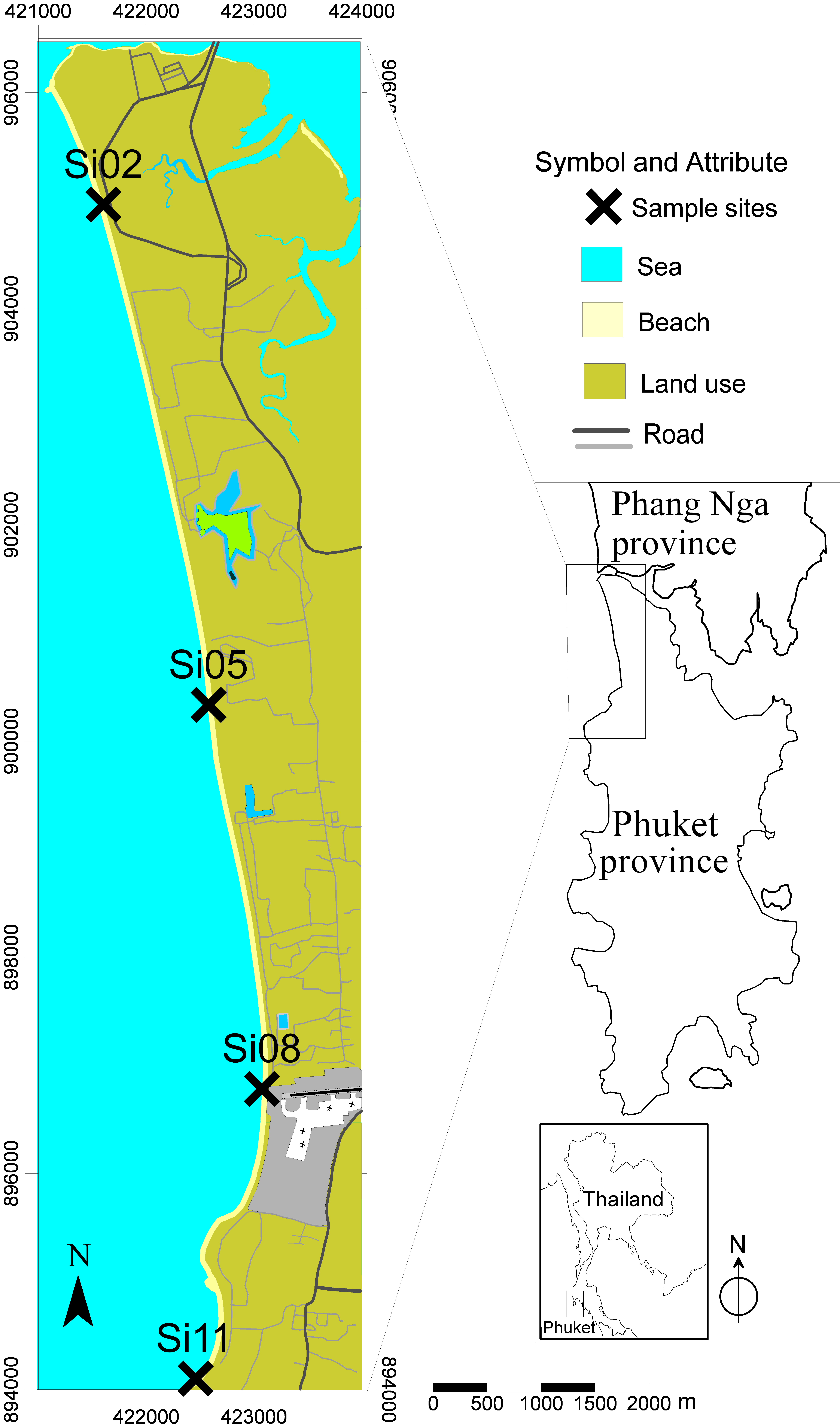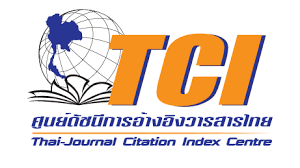Correlation between Population of Mole Crab (Emerita emeritus L., 1767 ) and Marine Water Quality at Mai Khao Beach, Phuket Province
Keywords:
Correlation, Mai Kaow Beach, Mole crab, Marine Water QualityAbstract
Background and Objectives: Mole crab is an organism that is widely found in Phuket Province due to appropriate food source, environment, topography, and seashore that is conducive to the proliferation of the crab. Mole crab is therefore used as a raw material for Phuket local food and greatly contributes to the income to the local community. This research aimed to study the relationship between mole crab population and quality of marine water of Mai Khao beach, Phuket Province.
Methodology: Relationships between mole crab population and quality of marine water of Mai Khao beach, Phuket Province were analyzed using data of marine water quality index and mole crab population collected from 4 beach stations. All data were collected during the pre-summer period of 2020. Analysis of the relationships between the two variable sets was performed using factor analysis, which is a part of multivariate analysis, in order to determine cofactors between the data.
Main Results: The results revealed clear correlations between 16 bivariate data out of a total of 45 bivariate data. The group of correlated variables could be classified into 2 factors as created in the hypothesis. First, residential environment variable factors consisted of marine water quality indices, i.e., marine water temperature, DO, BOD, and COD, with the R-value ranging between 0.81 to 0.91; these factors were related to mole crab population density and marine water quality. However, only marine water temperature showed positively proportional relationship with the mole crab population density; the rest showed negatively proportional relationships with the mole crab population density. The second group of factors, i.e., dietary variable factors, were related to marine water quality in terms of the relationships with other ecosystems and living organisms; variables belonging to this group were pH value, salinity of marine water, PO4-P, and chlorophyll A, with the R-value ranging between 0.00 to 0.65. These second-group factors were not clearly correlated with the mole crab population density. In addition, some indices did not show any relationships with the above 2 groups of factors, i.e., total nitrogen and total phosphorus.
Conclusions: There were two groups of factors that exhibited relationships between the mole crab population and quality of marine water data. Factor 1: residential environment variable factors, statistically and directly related to the mole crab population density. The related marine water quality indices were water temperature, DO, BOD, and COD. Factor 2: dietary variable factors, related to marine water quality. All indices of this group of factors did not clearly show the relationships with the mole crab population density, but exhibited relationships with other ecosystems and living organisms. The marine water quality indices were pH value, salinity of marine water, PO4-P, and chlorophyll A.
Practical Application: The relationships between mole crab population and quality of marine water indicate the chance of survival of mole crab in marine water. The results could be used to determine and monitor marine water quality if commercial breeding of mole crab is to be conducted.
References
Platong, S. and Platong, J., 2003, “A Review of Mole Crabs (Hippidae) in the Gulf of Thailand: with a New Record of Hippa Truncatifrons (Miers,1878) and unidentified Emerita sp,” 20th Pacific Science Congress “Science & Technology for Healthy Environment”, 17-21 March 2023, Bangkok, Thailand, 344 p.
Efford, I.E., 1966, “Feeding in the Sand Crabs, Emerita Analoda (Stimpson) (Decapoda, Anomura),” Crustaceana, 10 (2), pp. 167-182.
Koedprang, W., Phetchaiya, T. and Khakhong, S., 2016, “Effect of Water Salinity on Survival Rate and Growth Performances of Mole Crab (Emerita emeritus Linn. 1767),” RMUTSV Research Journal, 9 (1), pp. 14-23. (In Thai)
Boonruang, P. and Phasuk, B., 1975, “Species Composition and Abundance Distribution of Anomuran Sand Crabs, and Population Bionomics of Emerita emeritus (L.) along the Indian Ocean Coast of Thailand,” Research Bulletin, 8, pp. 1-19.
Khongsang, A., 2020, “Relationship between Phytoplankton Community and the Distribution of Mole Crab (Emerita emeritus L., 1767) at Mai Khao Beach, Phuket Province,” Proceedings of The National Environmental Conference 2020, Burapha University, Chon Buri. pp. 1-10. (In Thai)
Suteerasak, T., Tanchana, S., Limsakul, W., Nuisriram, N., Inthong, S. and Parkiatwong, J., 2020, “Assessment of “Water and Sand Quality in Mai Khao Beach, Phuket Province,” Proceedings of The National Environmental Conference 2020, Burapha University, Chon Buri. pp. 1-10. (In Thai)
Limsakul, W., Suteerasak, T., Koedsin, W., Tanchana, S. and Chongsrirattanakun, W., 2021, “The Quantity of Metal Elements in Sand of Mai Khao Beach Phuket Province,” Burapha Science Journal, 26 (3), pp. 1456-1475. (In Thai)
Vecchia, A.D., Rigotto, C., Staggemeier, R., Soliman, M.C., de Souza, F.G., Henzel, A., Santos, E.L., do Nascimento, C.A. de Quevedo, D.M., Fleck, J.D., Heinzelmann, L.S., de Matos Almeida, S.E. and Spilki, F.R., 2015, “Surface Water Quality in the Sinos River Basin, in Southern Brazil: Tracking Microbiological Contamination and Correlation with Physicochemical Parameters,” Environmental Science and Pollution Research, 22, pp. 9899–9911.
Aguirre, B.P., Masachessi, G., Ferreyra, L.J., Biganzoli, P., Grumelli, Y., Panero, M.D., Wassaf, M.M., Pisano, M.B., Welter, A., Mangeaud, A., Ré, V., Nates, S.V. and Pavan, J.V., 2019, “Searching Variables to Assess Recreational Water Quality: the Presence of Infectious Human Enterovirus and its Correlation with the Main Variables of Water Pollution by Multivariate Statistical Approach in Córdoba, Argentina,” Environmental Science and Pollution Research, 26, pp. 6586–6601.
Suteerasak, T., Limsakul, W. and Koedsin, W., 2023, “Estimation of Beach Profile Changes after Monsoon in the Mai Khao Beach,” KKU Science Journal, 51 (1), pp. 31-43. (In Thai)
Sinsomboomthong, S., 2014, Multivariate Analysis, Chula Book Center, Bangkok. (In Thai)
Pinyo, T., 2018, “Techniques for Interpreting the Results of Factor Analysis in Research Work,” Panyapiwat Journal, 10 (Special), pp. 292-304. (In Thai)
Suteerasak, T., Lim-u-sanno, P. and Bhongsuwan, T., 2021, “Magnetic Properties and Correlations with Iron, Aluminum and Titanium in Rock and Soil of Phuket Province,” KMUTT Research and Development Journal, 4 (22), pp. 279-294. (In Thai)
Zhiyuan, W., Dengfeng, W., Huiping, Z. and Zhiping, Q., 2011, “Assessment of Soil Heavy Metal Pollution with Principal Component Analysis and Geoaccumulation Index,” Procedia Environmental Sciences. 10, pp. 1946-1952.
Gergen, I. and Harmanescu, M., 2012, “Application of Principal Component Analysis in the Pollution Assessment with Heavy Metals of Vegetable Food Chain in the Old Mining Areas,” Chemistry Central Journal, 6 (156), pp. 1-13.
Yalcin, F., Kilic, S., Nyamsari, D.G., Yalcin, M.G. and Kilic, M., 2016, “Principal Component Analysis of Integrated Metal Concentrations of Bogacayi Riverbank Sediments in Turkey,” Polish Journal of Environmental Studies, 25 (2), pp. 471-485.
Gomalanon, P., 2017, Species and Distribution of Sand Crabs (Crustacea : Hippoidea) in Chalathat Beach, Songkhla Province, Master of Science Thesis, Marine and Coastal Resources Management, Faculty of Environmental Management, Prince of Songkla University, 101 p. (In Thai)
Paibulkichakul, C., Tomuenwai, C., Tangian, T. and Paibulkichakul, B. 2020, “Coastal Water Quality Assessment Using Dominant Genera of Phytoplankton,” King Mongkut's Agricultural Journal, 38 (1), pp. 104-111. (In Thai)
Thirunavukkarasu, S., Vasanthi, R., Karunasagaran, G. and Munuswamy, N. 2020, “Coastal Water Quality Impact on Community Structure and Genotoxicity of Marine Zooplankton,” Regional Studies in Marine Science, 39, 101392, pp. 1-13.
Alkhalidi, M.A., Hasan, S. and Almarshed, B.F. 2023, “Assessing Coastal Outfall Impact on Shallow Enclosed Bays Water Quality: Field and Statistical Analysis,” Journal of Engineering Research, (In Press), pp. 1-15. (https://doi.org/10.1016/j.jer.2023.09.031)
Jamshidi, S. and Bakar, N.B.A., 2011, “Variability of Dissolved Oxygen and Active Reaction in Deep Water of the Southern Caspian Sea, Near the Iranian Coast,” Polish Journal of Environmental Studies, 20 (5), pp. 1167-1180.
Weymouth, F.W. and Richardson, C.H., 1912, “Observations on the Habits of the Crustacean Emerita analoga,” Smithsonian Miscellaneous Collections 59 (7), pp. 1-13.

Downloads
Published
How to Cite
Issue
Section
License
Copyright (c) 2024 King Mongkut's University of Technology Thonburi

This work is licensed under a Creative Commons Attribution-NonCommercial-NoDerivatives 4.0 International License.
Any form of contents contained in an article published in Science and Engineering Connect, including text, equations, formula, tables, figures and other forms of illustrations are copyrights of King Mongkut's University of Technology Thonburi. Reproduction of these contents in any format for commercial purpose requires a prior written consent of the Editor of the Journal.




